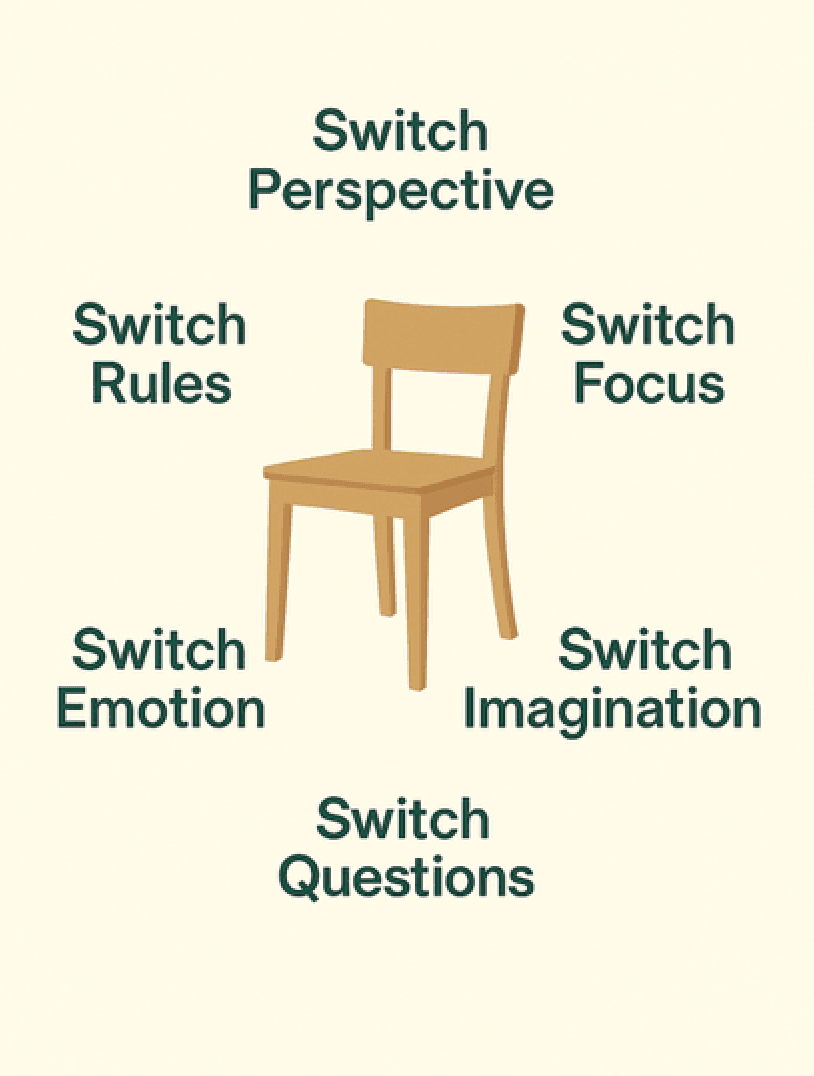Switch Thinking is the way of moving back and forth from what I call Box Mode (i.e.structured) to Ball Mode (i.e. imaginative).
This means that you can unlock greater creativity, agility and energy – in minutes!
To help people make this change I have developed 6 Switches.
These are: Switch Perspective, Focus, Imagination, Emotion, Questions and Rules.
The 6 Switches are fast, easy and practical.
Let’e illustrate these switches by talking about a chair.
Why a chair?
Its completely random.
A chair is one of the most ordinary objects in our daily lives.
It seems fixed, defined, and obvious.
The chair of course is a metaphor for any problem, an idea, a situation, a relationship, a challenge — can be seen in dozens of new ways.
Here’s how each switch transforms the chair:
1. Switch Perspective
See it from a new angle, role, or viewpoint.
A chair looks completely different depending on who’s looking:
- An interior designer sees style, lines, form, and how it fits a room.
- A parent with toddlers sees safety, sharp edges, stability, hazards.
- A cat sees a hiding place or warm perch.
- A photographer sees a prop.
- A historian sees craftsmanship and era.
One object — multiple perspectives.
One situation — multiple truths.
2. Switch Focus
Shift your attention to a different part of the chair.
Depending on what you focus on, the “chair” becomes a different problem or opportunity:
- Size
- Weight
- Height
- Cost
- Comfort
- Material
- Durability
- Sustainability
- Portability
- Colour
By switching focus, you switch meaning.
By switching meaning, you switch possibilities.
3. Switch Imagination
Use “What if?” to open doors your rational mind normally keeps shut.
Here, the chair becomes magical:
- What if the chair were alive?
What stories would it tell? Who has sat on it? What has it witnessed? - What if the chair could move on its own?
Where would it go? Who would it help? - What if the chair had superpowers?
What would it transform into?
Imagination dissolves assumptions and restores play — the birthplace of creativity and innovation.
4. Switch Emotion
Add feeling, meaning, or personal resonance.
A chair can change dramatically when emotion is added:
- “This is not just a chair — it was your late mother’s favourite chair.”
- “This chair reminds me of my childhood home.”
- “I feel relaxed in this chair.”
- “I feel anxious when I see this chair.”
Emotions reveal hidden significance and influence behaviour far more than logic alone.
They uncover why it matters.
5. Switch Rules (Switch Your Assumptions)
Challenge the rules, conventions, or hidden assumptions behind the chair.
Ask:
- Why does a chair need four legs?
- Could it have six?
- Does a chair have to be owned?
Could it be shared or temporary? - Must all chairs around a table look the same?
Why can’t they all be different?
Switching rules reveals how often our thinking is trapped inside invisible boundaries — and how freeing it is to challenge them.
6. Switch Questions
Ask different questions to unlock different insights.
A chair becomes far more interesting when you change the question:
- Do we even need a chair at all?
- Can we share one chair among many people?
- What would a “standing chair” look like?
- What could we call it instead? A “body-holder”? A “rest device”?
- What problem does the chair really solve? Is that still relevant?
The quality of your questions determines the quality of possibilities you see.
Switching questions changes the future you can imagine.
In summary:
In this simple example, I tried to show that you can think about a chair and hence any situation, problem or opportunity differently.
All it requires is a simple switch.
A switch that takes moments.
This means you are more in control of your career, relationships and life.

